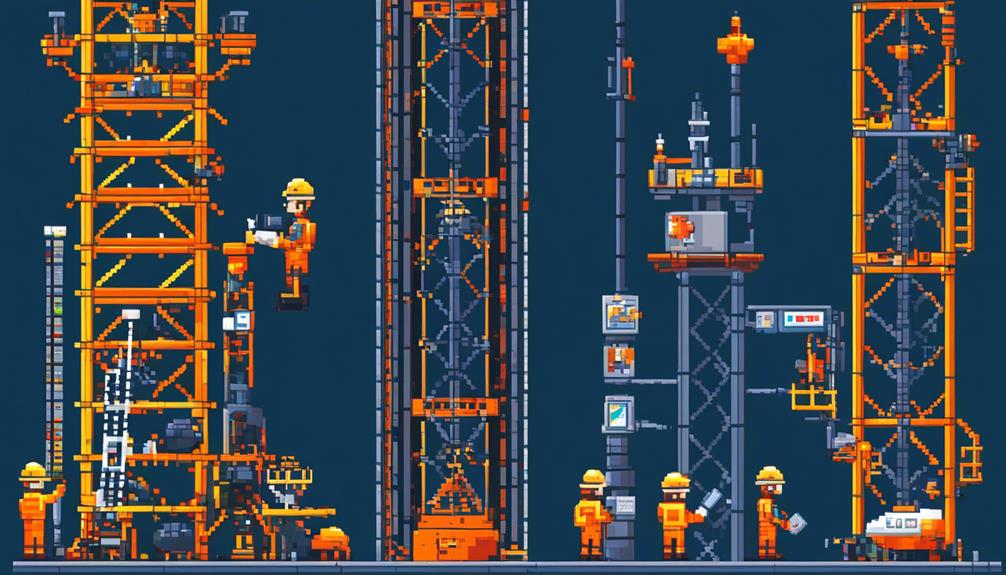Telecom tower maintenance is crucial for ensuring uninterrupted communication services and the overall integrity of the tower infrastructure. Regular inspections and preventive maintenance are key best practices that help identify potential structural weaknesses, prevent equipment failure, and address environmental hazards.
However, the complexity of telecom towers and the need for accurate reflection of their infrastructure require advanced tools such as digital twins, like OpenTower iQ, to efficiently plan and execute maintenance activities.
In this discussion, we will explore the importance of regular maintenance, the types of telecom towers, critical tips for maintenance, and resources available for efficient tower upkeep.
By following these best practices, stakeholders can effectively protect telecom sites from maintenance issues and ensure seamless operations.
Key Takeaways
- Regular maintenance and inspections are essential for optimal performance, longevity, and uninterrupted service of telecom equipment.
- Different types of telecom towers have varied maintenance requirements and frequencies, and tower design depends on specific requirements and environmental conditions.
- Implementing preventive maintenance strategies, such as regular inspections, repairs, and comprehensive record-keeping, can prevent equipment failures and extend the tower's service life.
- Downtime in telecommunications operations can lead to operational disruptions, financial losses, lost opportunities, customer churn, and a damaged reputation, highlighting the critical impact of maintenance on business revenue.
Importance of Regular Maintenance
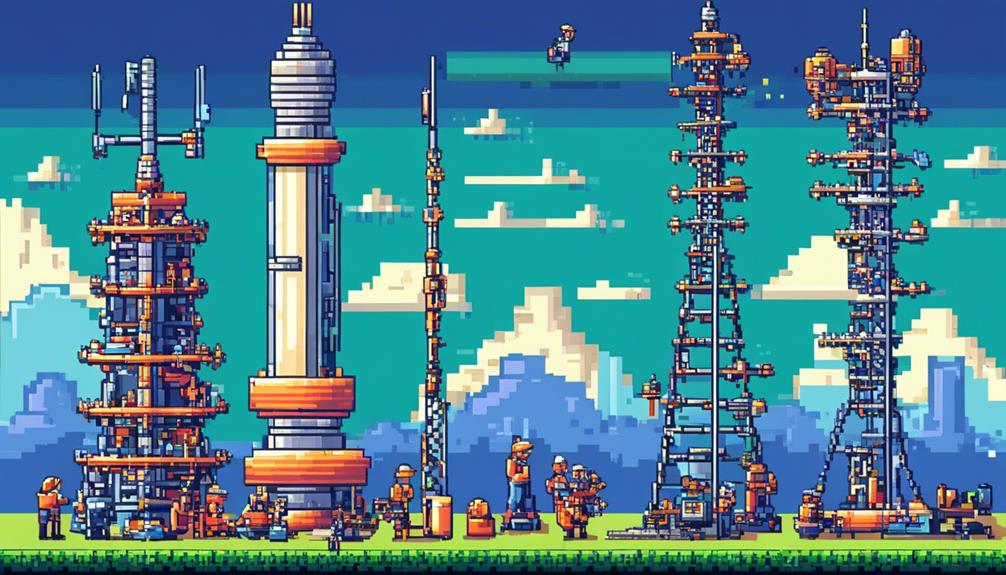
Regular maintenance is crucial in ensuring the optimal performance and longevity of telecom equipment, particularly in the context of telecom towers. Regular maintenance checks are necessary to prevent potential issues and component failures which could lead to interruptions and outages. By conducting routine maintenance, telecom tower operators can extend the usable lifetime of their equipment, ultimately reducing the need for expensive replacements.
Efficient monitoring and maintenance solutions are especially crucial in the era of 5G technology. With the increased complexity and sensitivity of 5G networks, regular maintenance becomes even more essential to ensure uninterrupted service. Regular checks can help identify and address any potential issues before they escalate, minimizing downtime and customer dissatisfaction.
One key aspect of regular maintenance is optimizing energy usage. By conducting routine inspections and implementing energy-efficient practices, telecom tower operators can reduce unnecessary energy consumption, resulting in cost savings and a smaller carbon footprint. Additionally, regular maintenance can extend the lifespan of telecom towers themselves, reducing the need for new tower installations and the associated costs.
Moreover, regular maintenance prevents interruptions and outages that may prompt customers to seek new telecom providers. By proactively addressing potential issues, telecom tower operators can maintain a high level of customer satisfaction and loyalty, ultimately contributing to the success and profitability of their businesses.
Frequency of Tower Maintenance
The frequency of tower maintenance is a crucial aspect of ensuring the optimal performance and longevity of telecom towers. To achieve this, maintenance schedule optimization and the implementation of preventive maintenance strategies are essential.
Regular inspections play a vital role in identifying potential issues and addressing them promptly, minimizing downtime and reducing the risk of major failures.
Maintenance Schedule Optimization
Optimizing the frequency of tower maintenance is crucial in ensuring efficient monitoring and maintenance solutions, particularly with the advancement of 5G technology. Maintenance schedule optimization is a key component of telecom tower maintenance best practices.
The frequency of routine maintenance checks depends on local regulations, with self-supporting towers typically requiring checks every three years and guyed towers every five years. However, certain situations, such as threats to human life or property and extreme weather conditions, may necessitate more frequent checks.
Different tower types, including lattice, guyed, monopole, camouflage, and mobile towers, have varied maintenance requirements. Implementing a preventive maintenance strategy through regular inspections and repairs helps prevent problems and component failures, ultimately extending the usable lifetime of telecom equipment.
Preventive Maintenance Strategies
To effectively maintain telecom towers, it is imperative to implement preventive maintenance strategies that address the frequency of tower maintenance, ensuring the reliability and longevity of the infrastructure.
Tower maintenance schedules vary depending on local regulations, but generally range from every three to five years. However, certain situations, such as extreme weather conditions or threats to human life or property, may require more frequent tower maintenance checks.
Different tower types, such as lattice, guyed, monopole, and camouflage towers, have varying maintenance requirements and frequencies.
Preventive maintenance strategies, including regular inspections and repairs, play a crucial role in identifying potential issues and preventing equipment failures.
By conducting regular upkeep and accounting for weather conditions, telecom tower owners can maintain a robust and reliable infrastructure.
Comprehensive records of maintenance activities and outcomes are essential for effective tower maintenance and planning.
Importance of Regular Inspections
Regular inspections are essential in ensuring the reliability and longevity of telecom towers. They help identify structural weaknesses, environmental hazards, and potential system failures. These inspections play a crucial role in preventing equipment failure and addressing wear and tear caused by environmental factors.
By conducting regular inspections, tower operators can maintain uninterrupted service. This is paramount in avoiding lost opportunities, financial losses, and damage to the provider's reputation. Additionally, regular inspections enable preventive maintenance, allowing potential issues to be identified before they cause system failures.
This not only extends the tower's service life but also optimizes energy usage. To implement an effective maintenance strategy for disaster prevention, regular and scheduled maintenance, structural integrity checks, and antenna and equipment inspections should be incorporated.
Types of Telecom Towers
When it comes to telecom towers, there are various types that serve different purposes.
The choice of tower material and design plays a crucial role in determining the tower's strength and stability.
Understanding the different types of telecom towers and their characteristics is essential for effective tower maintenance and ensuring optimal performance.
Tower Materials
Lattice towers and monopole towers are two common types of telecom towers used in the telecommunications industry.
Tower materials play a crucial role in the construction and maintenance of these structures, as they need to withstand various environmental conditions.
Lattice towers are typically made of steel and are built on triangular or square bases, providing stability and strength. These towers are often supported by guy wires, which provide additional support and help to mitigate wind loads.
On the other hand, monopole towers are simple tube-shaped structures that are usually made of steel or concrete.
The choice of tower material depends on factors such as the desired height, load-bearing capacity, and the specific environmental conditions of the tower location.
Tower Design
Tower design plays a crucial role in the construction and maintenance of telecom towers, as different types of towers are used to meet specific requirements and environmental conditions. The choice of tower design depends on factors such as height requirements, load-bearing capacity, aesthetics, and site location. Here are some common types of telecom towers:
| Tower Design | Description |
|---|---|
| Lattice | Built on triangular or square bases, lattice towers provide excellent strength and stability. They are commonly used for tall structures and in areas with high wind speeds. |
| Guyed | These towers have added support from guy lines, which are cables or wires anchored to the ground. Guyed towers are cost-effective and suitable for areas with limited space or uneven terrain. |
| Monopole | Monopole towers are simple tube-shaped structures that are aesthetically pleasing and blend well with urban landscapes. They are ideal for areas with height restrictions or limited land availability. |
| Camouflage | These towers are designed to resemble trees or other landscape elements, minimizing their visual impact. Camouflage towers are commonly used in urban areas where aesthetics are important. |
| Mobile | Also known as Cell on Wheels (COW), these towers are portable and can be easily deployed to remote sites or used during maintenance activities. They provide temporary coverage and flexibility.
Proper maintenance of telecom towers involves regular inspection and addressing maintenance tasks promptly to ensure optimal performance and prevent equipment issues.
Components of a Telecom Tower
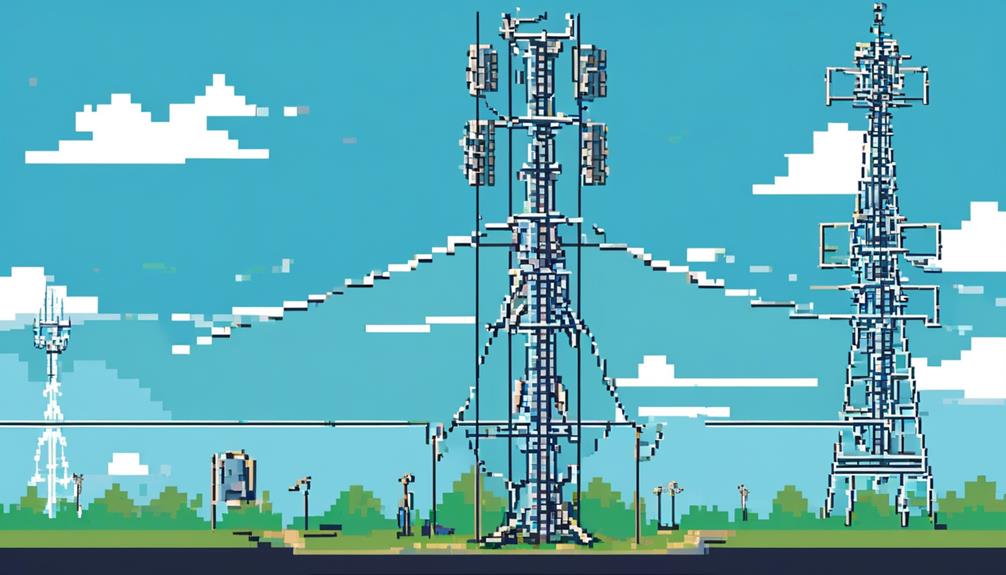
Key components that enable the smooth operation of a telecom tower include various communications equipment, energy management assets, and supplementary power sources. These components play a crucial role in ensuring reliable and uninterrupted communication services.
Communications equipment is at the heart of a telecom tower. It includes antennae, transceivers, and amplifiers. Antennae receive and transmit signals, while transceivers convert signals from one form to another. Amplifiers strengthen the signals, enabling them to travel long distances without degradation. Regular maintenance and inspection of these components are essential to identify any issues and ensure optimal performance.
Energy management assets are another critical component of a telecom tower. These assets provide power to the tower, ensuring its uninterrupted operation. Power modifiers and meters are used to maintain a stable energy supply and monitor power consumption. Regular checks of these assets should be included in the tower's maintenance schedule to detect and rectify any power-related issues promptly.
Supplementary power sources are necessary to ensure continuity of service during power outages or disruptions. Telecom towers rely on batteries, renewable sources, and generators to supplement their energy needs. Batteries provide backup power during short outages, while renewable sources such as solar panels harness the sun's energy to generate electricity. Generators are used for extended power outages. Regular testing and maintenance of these supplementary power sources are crucial to ensure their reliability and effectiveness.
Impact of Downtime on Operations
Downtime in telecommunications operations can have severe consequences, including operational disruptions and significant financial implications. Service disruptions can lead to lost opportunities, customer churn, and a damaged reputation.
Moreover, the financial losses incurred during downtime, as exemplified by T-Mobile's payment of almost $20 million for a twelve-hour outage, highlight the critical impact on business revenue.
Therefore, it is crucial for telecom tower maintenance to prioritize effective strategies to minimize downtime and ensure uninterrupted service.
Downtime Consequences
The consequences of downtime on telecom operations can be far-reaching, resulting in lost opportunities, financial losses, and customer migration to other providers. Outages can have significant financial impacts, with some businesses losing over $6 million due to network outages. For instance, T-Mobile faced a substantial financial penalty of nearly $20 million for a twelve-hour outage in 2020. To mitigate these risks, telecom service providers must prioritize regular maintenance of their towers and equipment. By implementing multiple energy backups, optimizing efficiency, and standardizing software configurations, providers can reduce the likelihood of downtime and minimize its impact. It is also crucial to maintain visibility into the network and establish performance thresholds to promptly identify and address any potential issues.
| Consequences of Downtime |
|---|
| Lost Opportunities |
| Financial Losses |
| Customer Migration |
The consequences of downtime on telecom operations can be far-reaching, affecting not only the financial health of the company but also its reputation and customer base. When network outages occur, businesses may miss out on potential revenue-generating opportunities, such as new contracts or partnerships. Additionally, the financial losses incurred during downtime can be substantial, with some companies losing millions of dollars. Moreover, the negative impact on customer experience and satisfaction may lead to customer churn, where subscribers migrate to other telecom service providers who can offer more reliable services. To avoid these consequences, telecom service providers must prioritize regular maintenance and ensure the robustness of their towers, equipment, and software configurations. By investing in proactive maintenance practices, providers can minimize downtime and its detrimental effects on their operations.
Operational Disruptions
Operational disruptions caused by network outages can have far-reaching consequences for telecom providers, impacting their ability to maintain efficient operations and deliver reliable services to customers. These disruptions can result in lost opportunities, financial losses, and damage to the reputation of telecom providers.
For instance, T-Mobile was fined $20 million for a 12-hour outage in 2020.
To minimize operational disruptions, telecom tower maintenance best practices include efficient monitoring through remote monitoring systems, standardized software configurations, and optimized energy usage. By maintaining network visibility and establishing performance thresholds, telecom providers can proactively identify and address potential issues before they escalate into significant downtime.
Additionally, implementing multiple energy backups can help mitigate the impact of power outages caused by natural disasters.
These preventive and predictive maintenance strategies, along with detailed record-keeping of maintenance activities, contribute to reducing operational disruptions and maintaining reliable telecom services.
Financial Implications
To understand the impact of network outages on the financial operations of telecom providers, it is crucial to examine the significant consequences that arise from operational disruptions. Downtime can lead to severe financial implications for telecom companies, resulting in lost opportunities and financial losses. In fact, one out of six businesses has reported losing over $6 million due to a network outage, highlighting the substantial financial impact. For instance, T-Mobile had to pay nearly $20 million for a twelve-hour outage in 2020, further underscoring the financial consequences of downtime on telecom operations. Implementing cost-effective strategies for telecom tower maintenance, such as regular inspections, preventive maintenance, remote monitoring, and advanced technologies, can help mitigate the financial implications of downtime. The table below summarizes some best practices for telecom tower maintenance:
| Best Practices | Benefits |
|---|---|
| Regular inspections | Early identification of potential issues |
| Preventive maintenance | Minimization of system failures |
| Remote monitoring | Real-time visibility into network |
Successful Tower Maintenance Strategies
Implementing effective strategies is crucial for successful tower maintenance. Telecom tower maintenance requires careful planning and execution to ensure the safety, compliance, and efficient operation of the tower infrastructure. Here are some best practices to consider when devising your tower maintenance strategies:
- Predictive Maintenance: Implementing a proactive approach to maintenance can help identify potential issues before they lead to system failures or downtime. By utilizing advanced technologies and monitoring systems, you can gather real-time data to detect anomalies and predict equipment failures. This allows you to address problems before they escalate, minimizing disruptions and optimizing tower performance.
- Detailed Record-Keeping: Maintaining comprehensive records of maintenance activities and outcomes is essential for successful tower maintenance. This includes documenting inspections, repairs, equipment replacements, and any other relevant information. These records serve as a valuable resource for future maintenance efforts, providing a historical perspective and aiding in troubleshooting.
- Regular Inspections and Maintenance: Conducting regular inspections is vital to identify and address structural weaknesses, equipment failures, and environmental hazards. Inspections should encompass all aspects of the tower, including antennas, cables, guy wires, and support structures. By promptly addressing any issues discovered during inspections, you can prevent further damage and ensure the overall integrity of the tower.
Critical Tips for Tower Maintenance
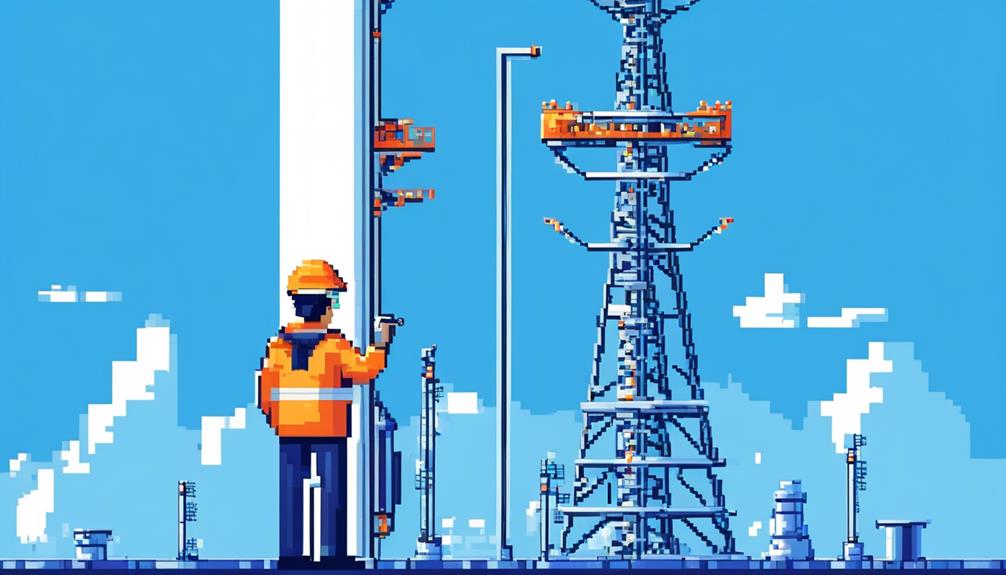
To ensure optimal tower performance and minimize disruptions, it is imperative to follow these critical tips for tower maintenance.
Regular maintenance plays a vital role in preventing problems and component failures. With the advent of 5G technology, efficient monitoring and maintenance solutions have become even more crucial.
One important practice is the implementation of predictive maintenance. By using advanced monitoring tools and techniques, potential issues can be identified before they cause system failures. This proactive approach allows for timely interventions and prevents costly downtime.
Additionally, preventive maintenance should be regularly performed to address potential issues that may arise. This includes tasks such as cleaning, lubricating, and inspecting the tower and its components.
Another tip for tower maintenance is to extend the usable lifetime of telecom equipment. This can be achieved by following manufacturer guidelines for maintenance and ensuring that all equipment is properly maintained and updated. Regularly checking for software updates and implementing them promptly can prevent compatibility issues and ensure optimal performance.
Furthermore, maintaining accurate records of maintenance activities is essential. This includes keeping track of maintenance schedules, inspections, repairs, and upgrades. These records not only serve as a reference for future maintenance but also provide valuable insights into the overall health and performance of the tower.
Resources for Efficient Maintenance
Utilizing remote monitoring and analytics is a crucial resource for efficient maintenance of telecom towers. By continuously tracking the performance of the tower infrastructure, this technology enables operators to identify and address issues in real-time, minimizing downtime and optimizing maintenance efforts.
In addition to remote monitoring, there are several other resources that can contribute to efficient telecom tower maintenance:
- Automation and Robotics: Implementing automation and robotics can streamline repetitive maintenance tasks, such as equipment testing or routine inspections. These technologies not only improve efficiency but also enhance worker safety by minimizing the need for manual intervention in hazardous situations.
- Training and Skill Development: Investing in training and skill development is essential for equipping maintenance crews with the knowledge and expertise required for effective tower maintenance. By staying up-to-date with the latest industry practices and technologies, maintenance personnel can perform their tasks more efficiently and accurately.
- Advanced Technologies: Leveraging advanced technologies, such as predictive maintenance solutions, can significantly improve the efficiency of telecom tower maintenance. Predictive maintenance uses data analytics and machine learning algorithms to identify potential issues before they cause system failures, allowing operators to take proactive measures and optimize maintenance schedules.
Unexpected Tips for Tower Maintenance
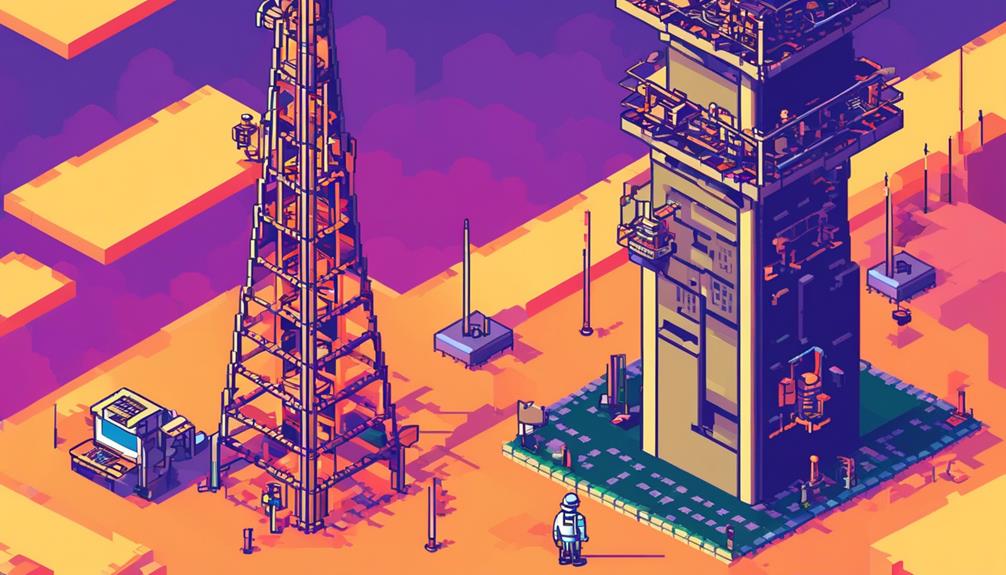
During tower maintenance, it is important to consider unexpected tips that can help optimize the efficiency and effectiveness of the maintenance process. These tips can help ensure the smooth operation of the telecom tower and minimize the risk of downtime or system failures. Here are some unexpected tips for tower maintenance:
| Tip | Description |
|---|---|
| Conduct Structural Integrity Checks | Regularly perform structural integrity checks to identify potential issues before they lead to system failures. This proactive approach can help prevent costly repairs and ensure the safety of the tower. |
| Inspect and Maintain Grounding Systems | Corrosion in grounding systems can weaken the tower's ability to withstand disasters such as lightning strikes. Regularly inspect and maintain grounding systems to prevent corrosion and ensure the tower remains properly grounded. |
| Utilize Advanced Technologies | Embrace advanced technologies such as remote monitoring and analytics to optimize tower maintenance. These technologies can provide real-time insights into tower health, enabling proactive maintenance and reducing costs. |
| Implement Change Management | Tower infrastructure changes are inevitable due to evolving regulations, technology advancements, and increased tenancy. Implement change management processes to effectively handle these changes and ensure the tower remains compliant and efficient. |
| Provide a Connected Data Environment | Ensure accessibility and collaboration by implementing a connected data environment. This allows all stakeholders to easily access critical tower data, facilitating efficient communication and decision-making during maintenance activities. |
Protecting Telecom Sites From Maintenance Issues
Regular and thorough maintenance is essential for protecting telecom sites from potential issues that could disrupt operations and compromise safety and compliance. By implementing the best practices in telecom tower maintenance, operators can ensure the longevity and efficiency of their infrastructure.
Here are three key strategies to protect telecom sites from maintenance issues:
- Adhering to local regulations and maintenance schedules:
Following local regulations and adhering to maintenance schedules specific to different types of towers is crucial. By doing so, operators can ensure efficient and safe operations while complying with industry standards.
- Utilizing predictive and preventive maintenance:
Implementing predictive and preventive maintenance strategies can address potential issues before they cause system failures. By regularly inspecting and maintaining tower infrastructure, including antenna and equipment, grounding systems, lighting systems, and foundations, operators can prevent major failures and ensure uninterrupted service.
- Embracing cost-effective technologies:
Remote monitoring, automation, and advanced technologies offer cost-effective ways to optimize tower maintenance. These tools enable real-time monitoring of tower performance, allowing operators to identify and address any maintenance issues promptly. Additionally, implementing automation can streamline maintenance processes, improving efficiency and reducing the risk of human error.
Frequently Asked Questions
How Do You Maintain a Cell Phone Tower?
To maintain a cell phone tower, preventive measures should be taken to ensure its structural integrity and prevent component failures. Regular structural inspections should be conducted to identify any potential issues.
Routine maintenance should be performed to keep the tower in optimal condition. Safety protocols should be followed to protect workers and equipment during maintenance activities.
What Is Corrective Maintenance in Telecom?
Corrective maintenance in telecom refers to the repair and restoration of failed equipment or facilities in the telecommunications industry. It involves troubleshooting and identifying the root cause of the failure, followed by implementing appropriate repair techniques to restore functionality.
Corrective maintenance is an essential component of maintenance strategies in telecom, ensuring that any equipment failures are promptly addressed and resolved. By combining preventive measures with corrective maintenance, telecom providers can maintain reliable and uninterrupted services for their customers.
What Is Tower Maintenance?
Tower maintenance is a critical aspect of ensuring uninterrupted and high-quality digital communication services. It involves regular inspections to identify structural weaknesses, prevent equipment failure, and address environmental hazards.
Common challenges include the need for frequent cleaning to remove debris and prevent signal interference.
Best practices for tower maintenance include regular inspections, detailed record-keeping, predictive and preventive maintenance approaches, and cost-effective strategies.
What Are the Requirements for Telecom Tower?
Telecom tower construction involves the installation process of erecting towers to support communication equipment. Safety measures for telecom towers are paramount to ensure the protection of workers and the public. These measures include proper grounding, securing equipment, and adherence to safety regulations.
Additionally, the environmental impact of telecom towers should be considered, such as minimizing the use of hazardous materials and implementing eco-friendly practices.
